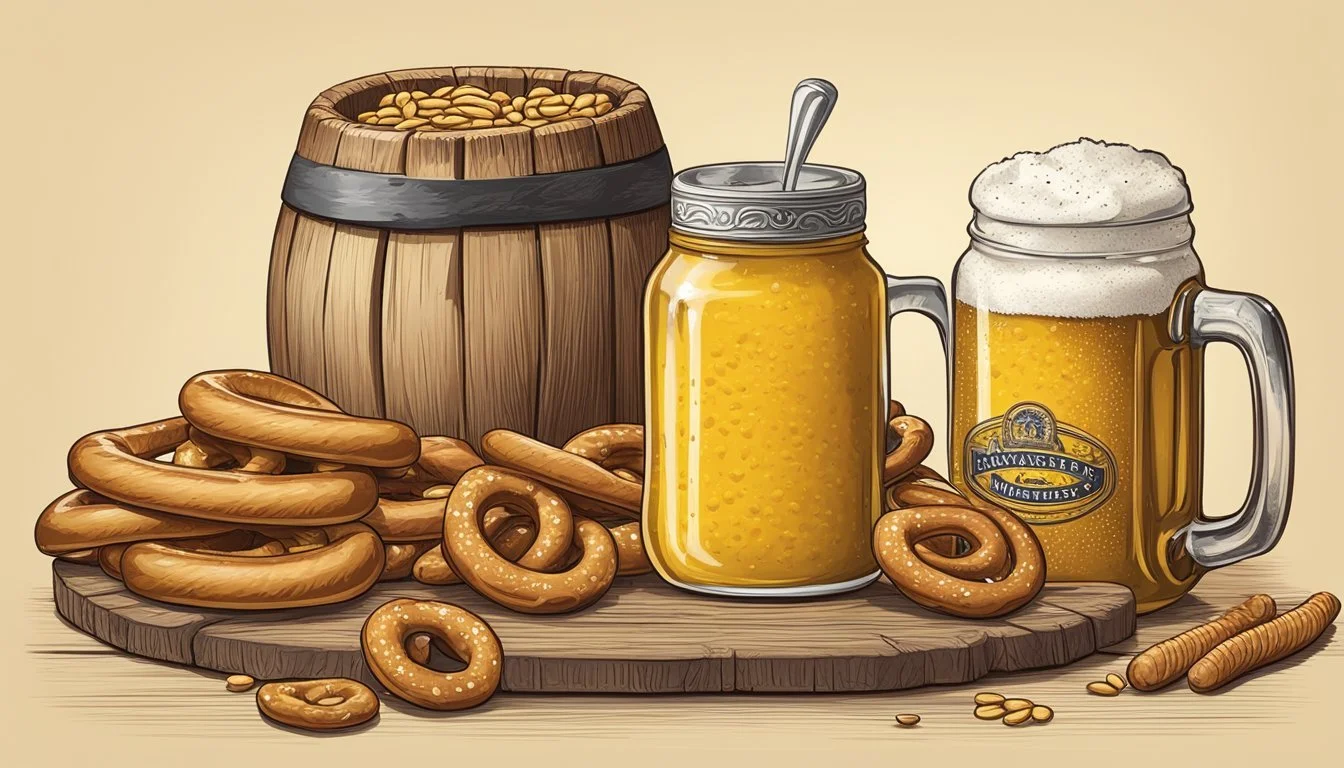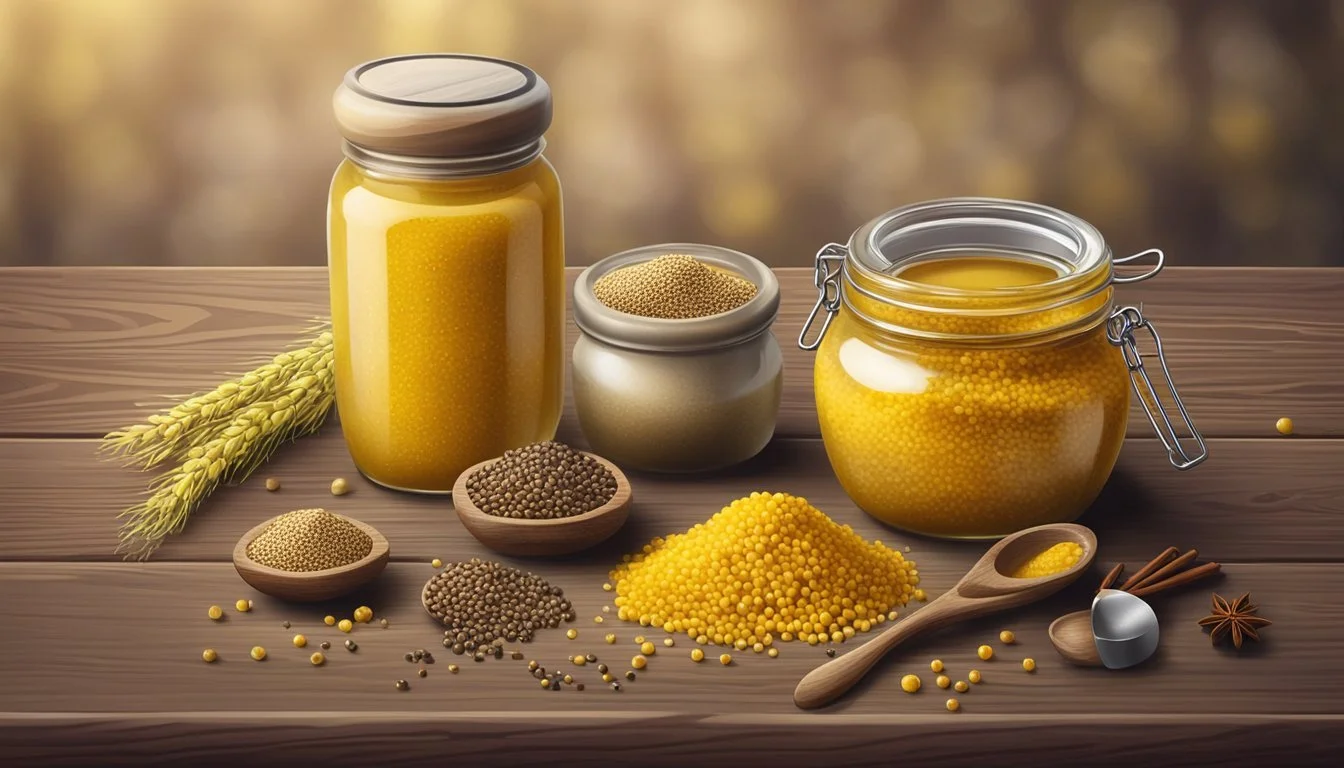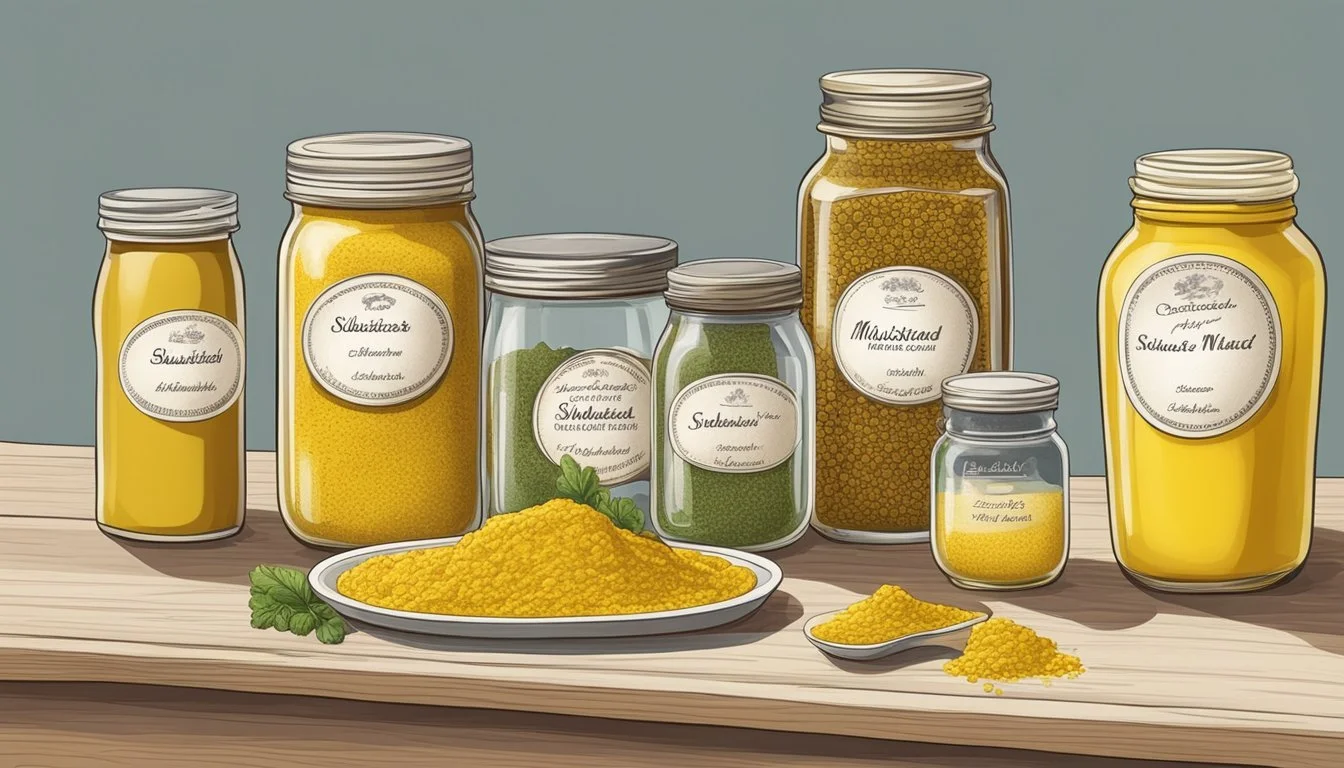Bavarian Sweet Mustard Substitutes
Top Alternatives for Your Dishes
Bavarian sweet mustard is a staple in the culinary tradition of Bavaria, renowned for its unique balance of sweetness and tang. This type of mustard is characterized by its distinctive flavor profile, which combines a gentle heat with a pronounced sugary aftertaste, setting it apart from other mustard varieties. It is traditionally made from a blend of coarsely ground mustard seeds, sweetening agents like honey or sugar, and a blend of spices that may include cinnamon or allspice. The consistency is usually thick and spreadable, making it a favored accompaniment for traditional German dishes such as Weisswurst and Leberkäse.
Substitutes for Bavarian sweet mustard may be sought for various reasons, ranging from dietary restrictions to simple unavailability. When looking for an alternative, the goal is to mimic the original condiment's complex flavor and texture. Though finding an exact match may be challenging, several options can provide a similar taste experience. These include using a combination of Dijon mustard mixed with a touch of honey or brown sugar, which can emulate the sweet, mildly spicy flavor profile of Bavarian sweet mustard.
Understanding the integral role Bavarian sweet mustard plays in the region's gastronomy is essential when considering substitutions. Its sweetness uniquely complements the savory notes of Bavarian dishes, making the search for an appropriate stand-in as much about preserving tradition as it is about savoring taste. Consequently, any substitute should respect the harmony between sweet and spicy elements that Bavarian sweet mustard so deftly achieves.
Understanding Bavarian Sweet Mustard
Bavarian sweet mustard is cherished for its unique blend of ingredients and its role as a traditional condiment in German cuisine. This section explores the components and characteristics that define this flavorful mustard.
Ingredients and Texture
Bavarian sweet mustard typically includes a mix of brown and yellow mustard seeds, which are steeped in vinegar to soften. The seeds are then coarsely ground, lending a grainy texture to the mustard. Sweetening agents like sugar or honey are added to achieve its distinctive sweetness. Additional ingredients such as sea salt and sometimes oil or cloves may be included to enhance flavor profile and consistency.
Mustard seeds: Coarsely ground yellow and brown seeds.
Vinegar: For steeping and tanginess.
Sweeteners: Sugar or honey to balance the acidity.
Sea salt: For taste and preservation.
Oil (occasionally) & Cloves (optional): For flavor subtleties and spice notes.
Flavor Profile
The flavor of Bavarian sweet mustard is a harmonious balance between sweet and tangy, with a mellow aftertaste. It lacks the sharp pungency of some more spicy mustards, avoiding a cloying sweetness. Honoring its Bavarian roots, this mustard is considered a staple in the German biergarten experience.
Culinary Uses
This mustard is commonly paired with traditional German dishes such as weißwurst (white sausage) and is a delightful addition to sandwiches, pretzels, and salad dressings. In the culinary context, Bavarian sweet mustard isn't just a condiment but also a versatile ingredient that can enhance the taste profiles of numerous dishes.
Health Considerations
From a health perspective, Bavarian sweet mustard is relatively low in calories and sodium, compared to many other condiments. However, the sugar or honey content can add to its caloric value. As for allergies, it is generally vegan, but individuals with mustard allergens should naturally avoid it. It's always advised to check labels for specific dietary needs.
Bavarian Sweet Mustard Substitutes by Composition
When substituting Bavarian sweet mustard, it’s important to consider the balance of sweetness, texture, and tanginess. Each alternative brings its own unique composition that can closely mimic or provide a satisfactory replacement for the sweet, creamy profile of Bavarian sweet mustard.
Honey Mustard
Honey Mustard is characterized by its sweet and mild taste, often containing a blend of honey and mustard. It provides a similar level of sweetness to Bavarian sweet mustard but usually lacks the depth of flavor provided by wine vinegar. The texture can vary from smooth to slightly coarse, depending on the preparation.
Sweetness: Honey brings natural sweetness.
Vinegar: Usually made with standard vinegar; lacks wine vinegar's flavor.
Texture: Creamy, similar to Bavarian sweet mustard.
Dijon Mustard
Dijon Mustard offers a complex flavor profile with a fine balance between tanginess and a hint of sweetness, often contributed by white wine or white wine vinegar. It’s more pungent than Bavarian sweet mustard but can serve as a sophisticated substitute in recipes due to its smooth texture.
Wine Vinegar: Often includes white wine vinegar for tanginess.
Sweetness: Subtly sweet, less so than Bavarian sweet mustard.
Texture: Generally smooth, comparable to Bavarian sweet mustard.
American Yellow Mustard
American Yellow Mustard typically provides a mild taste with a slight tangy kick, often attributed to vinegar and the distinctive yellow color from turmeric. It lacks the sweetness inherent in Bavarian sweet mustard, but its texture and mildness can be an acceptable substitute for those looking for an American twist.
Vinegar: Standard vinegar, more acidic, less wine-like.
Turmeric: Bold yellow color and earthy flavor notes.
Texture: Consistently smooth, akin to Bavarian sweet mustard, but not as rich.
By understanding these key differences and similarities in composition, one can select the most appropriate mustard substitute for their culinary needs.
Homemade Alternatives
Creating Bavarian sweet mustard at home involves crafting a balanced mustard base, carefully adding sweet elements, and adjusting the texture to suit individual preferences.
Creating a Mustard Base
The foundation of any mustard includes mustard seeds, vinegar, water, and salt. To mimic Bavarian sweet mustard, one should start by soaking whole mustard seeds in a mixture of water and apple cider vinegar, often preferred for its fruity undertone. Typically, a ratio of one part seeds to two parts liquid works well. After soaking for several hours or overnight, the seeds absorb the liquid, becoming plump and ready for further processing.
Adding Sweetness
Bavarian sweet mustard is known for its notable sweetness. Achieving this at home means incorporating sweeteners such as honey, brown sugar, or white sugar. These sweeteners should be added to the soaked mustard seeds before grinding. For every cup of soaked seeds, one might start with a quarter cup of sweetener, adjusting to taste. Honey imparts a natural and distinct flavor, while brown and white sugars offer varying degrees of caramel-like undertones.
Adjusting the Texture
Finally, the texture is an essential aspect of Bavarian sweet mustard. It should be smooth yet slightly grainy. To achieve this, transfer the mixture of soaked mustard seeds and sweetener into a food processor. Pulse until the desired consistency is reached—coarse for a more rustic substitute or finely ground for a creamier texture. Some individuals may prefer to strain the mixture for a silkier finish. Remember that mustard will thicken over time, so initially, it may appear runnier than expected.
Commercial Mustard Varieties as Substitutes
When looking for an alternative to Bavarian sweet mustard, several commercial mustard varieties offer distinct flavors and textures suitable for different culinary applications. Each substitute brings a unique balance of spiciness and texture that can complement a variety of dishes.
Stone Ground Mustard
Stone ground mustard features a coarser texture with partially crushed mustard seeds, offering a more robust flavor profile. Its granularity can be a good match for recipes that benefit from a visible mustard presence and a milder spiciness compared to hot mustards.
Whole Grain Mustard
Whole grain mustard is known for its visible, intact mustard seeds and a thick, rustic texture. It adds not only flavor but also a pleasant aesthetic and textural element to dressings and marinades. Due to its moderate oil content, it provides a creaminess without overpowering.
Hot Mustard
Hot mustard variants are characterized by their intense pungency and sharp spiciness that can awaken the palate. The heat level in hot mustard can vary, but they generally add a bold kick to dishes that might be reminiscent of the nuanced sweet-sharp flavor profile of Bavarian sweet mustard.
Horseradish-Based Options
Horseradish-based options, such as prepared horseradish or horseradish sauce, deliver a piquant punch similar to hot mustards. The texture of prepared horseradish can range from finely grated to coarsely chopped, and it often presents an oil-free alternative with a vigorous, peppery flavor.
Pairing Substitutes with Foods
Selecting the right Bavarian sweet mustard substitute can greatly enhance various dishes. This section guides readers on which substitutes best complement different types of foods while preserving the essence of traditional flavors.
For Traditional Bavarian Dishes
When it comes to classic Bavarian cuisine such as weißwurst, a traditional choice is whole grain mustard due to its rich flavor and textual contrast. It can closely mimic the complexity of Bavarian sweet mustard (senf). For a homemade touch, honey mustard mixed with a hint of garlic can be a delightful pairing with a warm, soft pretzel.
For Sandwiches and Wraps
Sandwiches and wraps benefit from a mustard substitute that can stand up to other strong flavors. Spicy brown mustard is often recommended for its robust taste, adding a depth of flavor without overwhelming the other ingredients. For a creamier texture, mayonnaise with a dash of honey and finely chopped pickles can substitute Bavarian sweet mustard in sandwiches to create a balanced and flavorful bite.
For Salads and Dressings
In salad dressings, where Bavarian sweet mustard typically adds sweetness and tang, a combination of honey, vinegar, and a dash of oil can serve as an effective stand-in. This blend aims to balance the sharpness and sweetness that the original mustard would provide. For those who desire a bit of spice, a touch of Dijon mustard can impart the necessary piquancy to vinaigrettes for greens.
For Vegan and Vegetarian Options
Vegan and vegetarian dishes (What wine goes well with vegetarian dishes?) often require substitutes that align with dietary preferences while also matching the flavor profile of Bavarian sweet mustard. A mixture of white vinegar and a small amount of sugar can be used to dress tofu or vegetable-based dishes. Additionally, mustard made from brown and black seeds can serve as a suitable vegan-friendly substitute, offering a complex flavor that doesn't rely on animal products.
Conclusion
When traditional Bavarian sweet mustard is unavailable, culinary creativity leads to a variety of substitutes that can closely mimic its unique sweet and tangy flavor profile. Dijon mustard, with its smooth consistency, offers a comparable tang and can be sweetened if needed.
Honey mustard serves as a readily accessible alternative, bringing in the desired sweetness paired with a mild tanginess. One can use it with confidence when catering to those who favor a milder taste.
Mayonnaise might seem unconventional, yet it can be doctored with a touch of honey and a bit of vinegar to approximate the creamy consistency and balance of sweet and tangy flavors.
For those preferring a more textured experience, whole grain mustard stands as a suitable option, especially when sweet elements such as honey or maple syrup are incorporated.
Lastly, yogurt mixed with maple syrup maintains a sweet edge while delivering a creamy base that echoes the original condiment's consistency.
They can ensure their dishes maintain integrity in both flavor and appearance by opting for these alternatives. No substitute will precisely replicate Bavarian sweet mustard's unique taste, but the proposed options offer an appealing semblance for most recipes.








